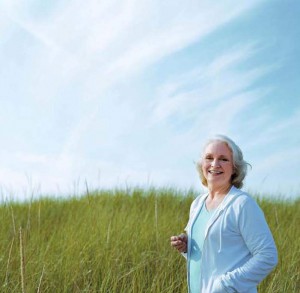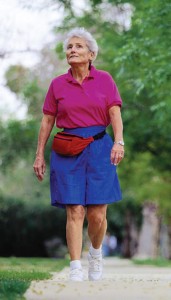February 25, 2011
By Tiffani Hill-Patterson
By now, everyone knows the health benefits of walking: improved cardiovascular function, weight loss, bone building, stress reduction. But did you know that taking a walk outside offers even more rewards?
Numerous studies show that getting outdoors improves not only your body but also your mind and spirit. Connecting with nature can help you see things in a new light. Keep in mind that it’s important even for early-stage Alzheimer’s patients to walk with caregivers, given the risk of wandering. It’s also important to talk with your doctor before taking on any exercise, particularly if you haven’t been exercising as a matter of habit.
Boost for the Body
While any physical activity improves the body, walking outdoors offers a bigger challenge. Professional trainer Tina Vindum, author of Step Out of the Gym and Into the Best Shape of Your Life, explains.
“From a physiological standpoint, we pull in more muscle fibers when we’re outdoors versus a flat gym floor or a treadmill, because we go up, we go down, we walk on grass, gravel, sand,” Vindum says. “We’re stressing the joint and the muscles more, and we’re actually strengthening the muscle fibers that we typically wouldn’t, so we burn more calories.”

Another physical benefit comes from breathing in the fresh air. According to the U.S. Environmental Protection Agency and the California Air Resources Board, indoor pollution rates are higher than outdoor rates, so people who spend most of their time inside are at greater risk. In fact, the indoor levels of some toxins range from two to 50 times higher than those outside.
Regular outdoor walks stimulate your brain. “Getting that fresh air to circulate through our bodies is critically important,” Vindum, faculty member of the American Council on Exercise says. “When we move our bodies and get our heart pumping and circulation going, our brain feeds on oxygen. We need it for energy—it is literally food for the brain and muscles.”
Rest for the Mind
Getting outdoors doesn’t boost only your physical capabilities. It also enhances your mental and emotional well-being by giving your brain a break and improving your mood.
In her article “The Healing Power of Nature,” Denise Mitten, Ph.D., professor of recreation, leisure services and wellness at Ferris State University, says eco-psychology blends environmental philosophy, ecology and psychology into a discipline that studies how the health of the planet impacts human health. “It is believed that the mind can be comforted and healed through time in natural environments,” she writes.

Research appears to support this theory. A 2003 study in the journal Psychology of Sport and Exercise found that running in a park resulted in a greater reduction in anxiety and depression than running through an urban area. And a 2008 study in Psychological Science shows the cognitive benefits of interacting with the great outdoors.
Frances E. Kuo, Ph.D., a faculty member at the University of Illinois at Urbana-Champaign who researches the effects of nature on human functioning, says, “We think that spending time in nature helps rest a part of the brain that’s involved in mental effort, giving it a chance to recuperate and be ready to tackle effortful tasks afterward.”
Also, exposure to the outdoors also seems to affect the nervous system and the brain actions responsible for our changing moods, Kuo adds. Part of this effect appears to come from the switch between artificial and natural light. Vindum says, “Studies have been done on mood, where somebody goes from a naturally lit environment to an artificially lit environment and their mood changes toward the negative.”
Binding a Community
Of course, nature offers societal benefits as well. Green spaces and parks become gathering places for communities, where people get to know one another and learn to look out for each other. Add the fact that greenery helps humans relax and renew, and it’s not hard to see why a 2001 study by Kuo and her colleagues showed that crime decreases in urban areas with green spaces.
On a more personal level, taking a walk around the block can enhance your social life. “We need the ability to interact with others, and it’s key to have that social time every day,” Vindum says. “When I go for a walk around my neighborhood, just a smile for a neighbor goes a long way. Just knowing and being familiar with our surroundings helps us feel like part of a community.”
Another thing Vindum has noticed is exercise becoming more of a social event. “People are not meeting up for food and drinks so much anymore. It’s ‘Let’s meet at the trailhead or let’s meet at the park,’ and that’s great quality time spent together interacting.”
Connecting with Spirit
Finally, taking a walk in the park can help you feel connected to the world as a whole and feel part of something bigger than your community.
Many scientists believe that humans have a biological need to connect with nature. In 1984, Pulitzer Prize winning scientist E.O. Wilson published Biophilia, an exploration of the basis of this attraction to the outdoors. In her paper, Mitten says that Wilson’s theory means that “people’s success in their search for a coherent and fulfilling existence depends on their relationship to nature.”
Vindum adds, “Research suggests that we have an affinity for nature that’s hardwired into us. We need it, we want it, if we don’t have it we become unwell.”
So the next time you put on your walking shoes, just walk on past the treadmill. Don’t get in your car. Just head out the door to the nature trail. Or to the beach. Or down by the river. Improving your health is as easy as a walk in the park.
Getting Started -Vindum offers these tips for taking a walk outside:
- Go for 10 minutes.
- Just walk. You don’t need to have a plan.
- Take it easy on yourself.
When you’re ready to bump up your outdoor stroll, try these suggestions:
- Look for green spaces on maps and walk there.
- Learn the trees, flowers, and birds on your trail.
- Smell the pine boughs or eucalyptus leaves.
- Incorporate textures. Walk on cobblestones. Take off your shoes for a stroll in the grass.
Source: www.ALZinfo.org. Author: Tiffani Hill-Patterson, Preserving Your Memory: The Magazine of Health and Hope; Summer 2010.











